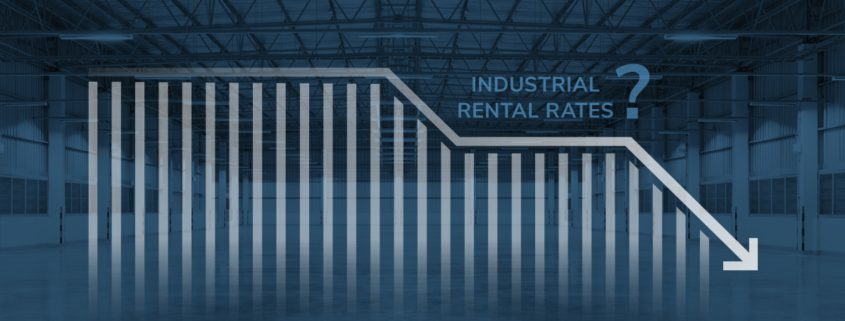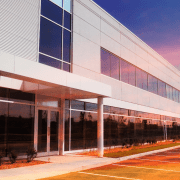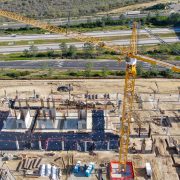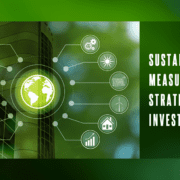Are Industrial Rental Rates Finally Coming Down?
Despite a steady increase in industrial property vacancy rates since midway through 2022, asking — and actual — rental rates have continued to increase in most Southern California markets. Fortunately, there’s a glimmer of hope for tenants as this upward trend in rental rates might finally be showing signs of a reversal.
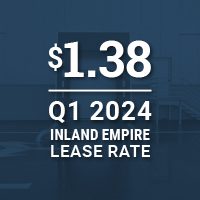
According to Voit’s recently released Q1 industrial market reports — which provide detailed analysis of the Inland Empire, Los Angeles County, Orange County, San Diego County, and Mid Counties markets — there has been a slight drop in industrial average asking lease rates in each market since the close of 2023, save for LA County, which has remained flat. In most markets, there has also been a doubling of vacancy year over year from Q1 2023, except for the Inland Empire, which practically tripled (from 2.15% to 6.42%). Asking rates for the Inland Empire had increased to a high of $1.44 in Q1 of 2023 before finally posting back-to-back quarterly decreases to $1.38 in Q1 of this year.
Is this a trend that is likely to continue?
Sean Sulivan, SIOR, SVP/Partner, in Voit’s Inland Empire office specializing in the sale and leasing of industrial properties, says the market for larger blocks of industrial space has been especially hard-hit. “The sub-50,000-square-foot market is still pretty competitive, and the lease rates have held a little bit better in that size range. But it starts to soften around 50,000 to 100,000 square feet, and then it gets really soft in the 100,000 to 300,000 square foot range. That’s where we’ve seen the steepest decline in rates and the biggest spike in vacancy as well.”
Another contributing factor to the downward trend in lease rates is the amount of new construction in the market. While new construction starts have slowed considerably, 24.5 million square feet of new inventory is still being built throughout the Inland Empire. With the decrease in demand, especially for large blocks of space, and the new inventory coming onto the market, “I think we’re going to see some lease rates continue to fall,” says Sulivan.
Sales Market
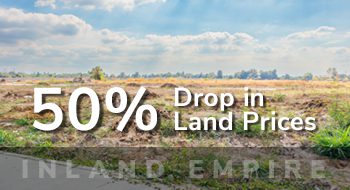
The decrease in leasing demand, the persistently higher mortgage interest rates, and a lingering disconnect between buyers and sellers on pricing have also combined to reduce sales transaction volume in SoCal markets by 40% to 50%. There has been a profound drop in institutional interest as well as owner-user sales. Although Sullivan says that with the elevation in interest rates, institutional investors have retreated, and the owner-user market has normalized somewhat. Whereas private investors were able to pay more during the four- to five-year window when interest rates were low. “Now we’ve kind of seen it flip back to where owner-users are able to pay a little more than investors because the user can simply just make the justification. ‘It’s for my business, and I’m just going to ride it out for the long term [benefit],’” Sullivan added.
Sullivan also reports that prices for industrially zoned land have fallen precipitously from their peak two years ago — by around 50%. “As lease rates fall and cap rates rise, the justification for paying an absurd price for land is just not there, so that’s why land prices have fallen so significantly,” says Sullivan.
SoCal Industrial Market Outlook
Although actual conditions vary from market to market, the overall leasing and sales picture for the other SoCal markets is largely consistent with the Inland Empire — a decrease in leasing and sales volume. Voit Real Estate Services provides a detailed examination of each market in their quarterly market reports. Let’s take a look at some of the highlights from these reports.
Los Angeles
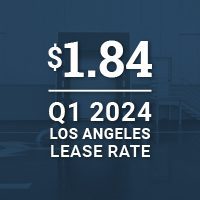
According to the Voit research team, the market is cooling off after an unprecedented bull run that lasted more than a decade. Vacancy nearly doubled year over year in LA County from 2.49% to 4.71%, but lease rates continued to increase through Q4 2023 before flattening out in Q1 at $1.84 — the most expensive in Southern California. However, the market is showing signs of softening. Sales transactions have dropped by nearly 50% due to higher interest rates and the retreat of institutional players, as well as the transfer tax instituted with Measure ULA (the so-called “mansion tax”), which makes all real estate transactions over $5 million subject to a transfer tax of up to 5.5% of the purchase price.
As active leasing requirements decline, landlords are offering more concessions to prospective tenants, according to Loren Cargile, SVP/Partner, in the Irvine office. “As the leasing market recalibrates, lease rate reductions, tenant concessions (free rent, tenant improvement allowances, early possession), and more tenant-friendly deal terms are quickly becoming more common… these conditions will present opportunities to secure more favorable terms compared to 12 to 18 months ago,” he reports.
He notes one encouraging factor for the market: activity in the Port of Los Angeles increased by 35% year to date compared with the first two months of 2023. A “very strong” positive correlation typically exists between port activity and the industrial vacancy rate.
Mid Counties
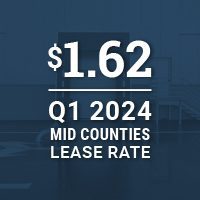
The Mid Counties market had been exceptionally resilient during the post-mid-2022 slowdown, closing 2022 with a 1.04% vacancy rate before creeping up to 2% in Q2 of 2023. In the last six months, however, that rate has doubled to just over 4% — well below the national average but alarming for its rapid rise. Rents declined for the first time in over a decade to $1.62 after steady quarterly increases. Voit researchers note that “the bulk of the region’s base industrial inventory was built in the 1970s and 1980s, much of which has become functionally obsolete to the logistics sector.”
The sales sector is expected to continue to struggle. There were only a dozen sales in the first quarter, totaling just over 353,000 square feet. In all of 2023, just 30 buildings changed hands, as compared to 83 in 2022.
Orange County
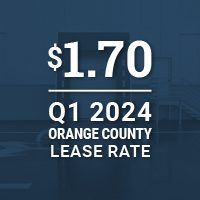
While Orange County’s vacancy rate doubled year over year (to 3.22%), it remains the tightest of the SoCal markets, with a minimal amount of sublease space available. Still, rents dropped from an all-time high of $1.79 to $1.70, giving tenants some leverage as landlords are offering concessions in the form of free rent and tenant improvement allowances. High-quality space still commands premium rates, but deals are taking longer to close. Some of the increase in vacancy is attributable to the five new buildings totaling over 600,000 square feet added last year. There is an additional 2+ million square feet currently under construction. Voit researchers anticipate that the vacancy rate will continue to increase throughout 2024.
Sales have slowed. There was a 50% drop in transactions from Q4 to Q1. Although some of the decrease can be attributed to the flurry of deals that occur at the end of each tax year. Institutional capital was involved in the larger transactions, including the recent $64 million sale by Clarion Partners of a 258,000-square-foot asset to Ares Management. In January, it was announced that Tishman Speyer had acquired a 32-acre, fully entitled development site in Irvine that will deliver a 600,000-square-foot asset.
San Diego
Like the rest of the Southern California markets, San Diego saw a doubling of the vacancy rate to 5.35% in Q1, as well as the second-highest availability rate 7.92% among the region’s markets. Some of the vacancy can be attributed to the 632,000 square feet of new industrial projects delivered in Q1 — 95% of which is unoccupied following a spec building boom. There have been 4.5 million square feet delivered since the start of 2022, much of it built on spec. The $1.50 rent was slightly up from Q1 2023’s rate of $1.47 and down just $0.02 from the previous quarter.
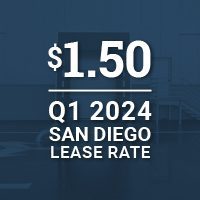
Industrial sales transactions have slowed for the last five quarters, with 2023 marking the first year since 2017 without a sales volume of a billion dollars. The trend continued into Q1, with less than $250 million of industrial sales recorded. But there are some encouraging signs as well. Greg Marx, SIOR, VP/Partner, reports that owner-user building purchases are up, which he says is surprising given the elevated interest rates.
Despite the slowdown in sales and leasing (down 25% year over year), Marx is taking a wait-and-see approach to the market as 2024 unfolds. “We’ve seen an unprecedented market through the last decade, given the rise in building values and rental rates, and now it seems as if we’re on a plateau,” he says.

